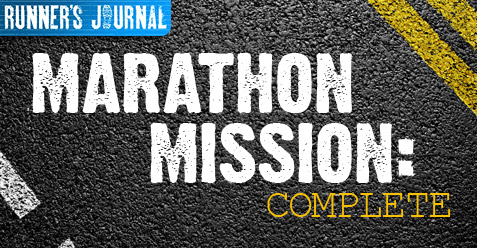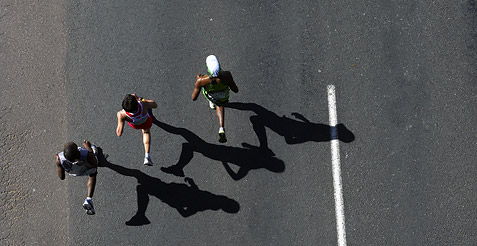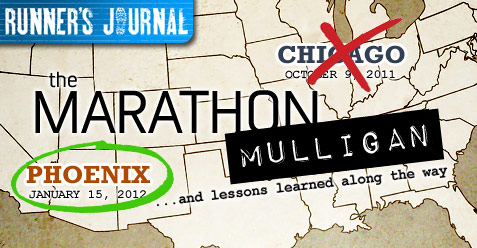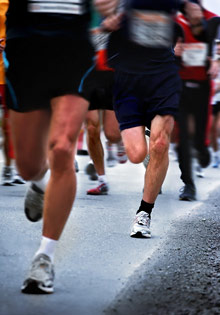
I couldn’t keep my eyes open. I was sitting against a fence, shivering, my calves tied into knots and my hip flexors threatening to burst into flames, and all I wanted to do was sleep. I’d force my eyes open, take a sip from the water bottle I’d been handed after I crossed the finish line, and then my eyes would slide shut again. Open, sip, repeat.
At one point, a concerned medic approached me. “Everything OK?” he asked. I forced a smile, told him I was fine, just needed to rest, and then I gave in. I shut my eyes once more and drifted off, maybe for 30 seconds, maybe for 10 minutes. I’d never been overwhelmed by the urge to sleep after a race, but I’d also never run a full marathon. I finished (just barely) the Chicago Marathon in October, but as I sat against that fence in the chute for the Arizona Rock ‘n’ Roll Marathon, I could finally say that I had run a marathon. Well, once I woke up, I could say it.
In my first post for this Runner’s Journal series, called “Why Run?”, I laid out some of the reasons I had been drawn back to the sport I’d abandoned in the 15 years since high school. Among those reasons, I wrote:
“I run to challenge myself, to set a goal and accomplish that goal. I run to find my limits and expand them, to redefine my comfort zone, to defy that voice inside my head that tells me my legs hurt too much and my lungs can’t take any more. I run to prove to myself that I can accomplish anything if I’m willing to work hard enough.”
The 3 hours and 44 minutes I spent running through Phoenix, Scottsdale and Tempe epitomized that paragraph. It was most definitely a challenge to accomplish my goal of running a full marathon. I blew past my limits and bulldozed my comfort zone during the race, and did my best to ignore “that voice” for the final six miles or so. I set out to run the whole race, and save for a handful of quick pit stops to guzzle some water or Gatorade, I did just that, even when “that voice” was pleading for a break at mile 24. I kept my feet moving, refused to walk, and crossed the finish line almost an hour faster than I did in Chicago last October. Then I took a nap.
I won’t pretend that I accomplished anything monumentally profound last weekend. Heck, it seems everyone is running marathons and half marathons these days. But it was a significant personal achievement, a moment I won’t ever forget, a moment I once thought would never happen, and yet there I was in the chute, medal in hand, mission accomplished. I was sleeping, but I was there.
I didn’t think I could, until I did
“I run to find my limits and expand them.” In hindsight, this line is perhaps the most accurate in the above paragraph. I remember how awful I felt after finishing my first half marathon, and how fantastic I felt seven months later after my third. My body wasn’t ready for 13.1 miles in Columbus, but by Cleveland, it knew what to expect and I cruised to a PR.
Last Sunday, my body was toast. I crossed the line sore, nauseous, thirsty and exhausted, certain I couldn’t have run another 10 feet. That’s exactly how I felt after my first half marathon. Now, a 13-mile run qualifies as an easy day. Will the pattern hold next month when I hop onto a plane to run the Tokyo Marathon?
Man, I hope so.

To be clear, I’m not suggesting Tokyo will be easy just because I finished the Arizona Marathon, but it should be easier. Not only will my body be better conditioned to handle 26.2 miles, but perhaps more importantly, I now know that I can, in fact, run a full marathon. Clearing that mental hurdle is huge. Telling yourself you can do something is one thing, but proving to yourself that you can do it is another.
At the expo the day before the race, I bought a shirt that said “Inspired to Run” on the back. Those three words sum things up beautifully for me. The act of running – of hitting the pavement or treadmill several times a week, braving the elements in the dead of winter or peak of summer, logging mile after mile after mile on lonely roads and rolling trails – isn’t a whole lot of fun. It’s not easy either. But it’s damn sure rewarding.
I’ve accomplished things during these two years of running that I never thought were possible. In about five weeks, I’ll add one more item to the list when I run a marathon in Tokyo. That’s incredible to me. And it’s no coincidence that, with each mental hurdle I’ve cleared in my training, my confidence in other areas of life has soared as well, driving me to pursue other personal and professional endeavors that once seemed out of reach and unattainable.
That may sound corny, but it’s the truth. There’s a reason running has exploded in popularity over the last decade. There’s a reason I have friends and family members emailing me for beginner training tips or advice on picking their first pair of running shoes (I’m no expert on either subject, by the way). There’s a reason people like my aunt, who ran her first marathon last year at the age of 53, fall in love with the sport. She’s done a bunch of half marathons, some sprint triathlons, joined a team for Ragnar last year, and probably accomplished so many other things that I don’t even know about. She also completed her second marathon in Arizona last weekend, and was thrilled to PR by about three minutes. That’s what it’s all about.
I am a marathoner. I had to wait three months longer than anticipated to be able to say that, but it doesn’t make it any less sweet. I can’t relax yet, though, not with the Tokyo Marathon on the horizon. I’m not sure how I’ll feel when I pick my routine back up Sunday with an easy five miler, but there’s only one way to find out.
You can follow us on Twitter and Facebook for content updates. Also, sign up for our email list for weekly updates and check us out on Google+ as well.


 When I cross the finish line in Phoenix Sunday morning (hopefully in 3:30 or faster), I will have finished two marathons within three months of each other. It’s a bit unbelievable considering how intimidating the thought of running 26.2 miles seemed to me at this time last year, but things get even crazier.
When I cross the finish line in Phoenix Sunday morning (hopefully in 3:30 or faster), I will have finished two marathons within three months of each other. It’s a bit unbelievable considering how intimidating the thought of running 26.2 miles seemed to me at this time last year, but things get even crazier.










